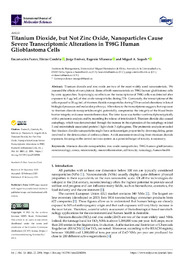Por favor, use este identificador para citar o enlazar este ítem:
https://hdl.handle.net/11000/30718Registro completo de metadatos
| Campo DC | Valor | Lengua/Idioma |
|---|---|---|
| dc.contributor.author | Fuster, Encarnación | - |
| dc.contributor.author | Candela, Héctor | - |
| dc.contributor.author | Jorge, Estévez | - |
| dc.contributor.author | Vilanova, Eugenio | - |
| dc.contributor.author | SOGORB, MIGUEL A | - |
| dc.contributor.other | Departamentos de la UMH::Biología Aplicada | es_ES |
| dc.date.accessioned | 2024-01-26T10:30:28Z | - |
| dc.date.available | 2024-01-26T10:30:28Z | - |
| dc.date.created | 2021-02-12 | - |
| dc.identifier.citation | International Journal of Molecular Sciences, 2021, 22, 2084 | es_ES |
| dc.identifier.issn | 1422-0067 | - |
| dc.identifier.issn | 1661-6596 | - |
| dc.identifier.uri | https://hdl.handle.net/11000/30718 | - |
| dc.description.abstract | Titanium dioxide and zinc oxide are two of the most widely used nanomaterials. We assessed the effects of noncytotoxic doses of both nanomaterials on T98G human glioblastoma cells by omic approaches. Surprisingly, no effects on the transcriptome of T98G cells was detected after exposure to 5 g/mL of zinc oxide nanoparticles during 72 h. Conversely, the transcriptome of the cells exposed to 20 g/mL of titanium dioxide nanoparticles during 72 h revealed alterations in lots of biological processes and molecular pathways. Alterations to the transcriptome suggests that exposure to titanium dioxide nanoparticles might, potentially, compromise the integrity of the blood brain barrier integrity and cause neuroinflammation. The latter issue was further confirmed phenotypically with a proteomic analysis and by recording the release of interleukin 8. Titanium dioxide also caused autophagy, which was demonstrated through the increase in the expression of the autophagy-related 3 and microtubule associated protein 1 light chain 3 alpha genes. The proteomic analysis revealed that titanium dioxide nanoparticles might have anticancerigen properties by downregulating genes involved in the detoxication of anthracyclines. A risk assessment resulting from titanium dioxide exposure, focusing on the central nervous system as a potential target of toxicity, is necessary. | es_ES |
| dc.format | application/pdf | es_ES |
| dc.format.extent | 26 | es_ES |
| dc.language.iso | eng | es_ES |
| dc.publisher | MDPI | es_ES |
| dc.rights | info:eu-repo/semantics/openAccess | es_ES |
| dc.rights | Attribution-NonCommercial-NoDerivatives 4.0 Internacional | * |
| dc.rights.uri | http://creativecommons.org/licenses/by-nc-nd/4.0/ | * |
| dc.subject | titanium dioxide nanoparticles | es_ES |
| dc.subject | zinc oxide nanoparticles | es_ES |
| dc.subject | T98G human glioblastoma | es_ES |
| dc.subject | nanotoxicology | es_ES |
| dc.subject | omics | es_ES |
| dc.subject | neurotoxicity | es_ES |
| dc.subject | neuroinflammation | es_ES |
| dc.subject | cell toxicity | es_ES |
| dc.subject | toxicology | es_ES |
| dc.subject | human health | es_ES |
| dc.subject.classification | Toxicología | es_ES |
| dc.subject.other | CDU::5 - Ciencias puras y naturales::57 - Biología | es_ES |
| dc.title | Titanium Dioxide, but Not Zinc Oxide, Nanoparticles Cause Severe Transcriptomic Alterations in T98G Human Glioblastoma Cells | es_ES |
| dc.type | info:eu-repo/semantics/article | es_ES |
| dc.relation.publisherversion | https://doi.org/10.3390/ijms22042084 | es_ES |

Ver/Abrir:
ijms-22-02084-v2.pdf
4,21 MB
Adobe PDF
Compartir:
 La licencia se describe como: Atribución-NonComercial-NoDerivada 4.0 Internacional.
La licencia se describe como: Atribución-NonComercial-NoDerivada 4.0 Internacional.
.png)